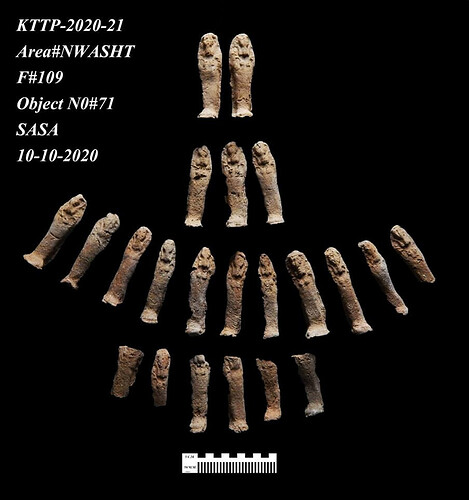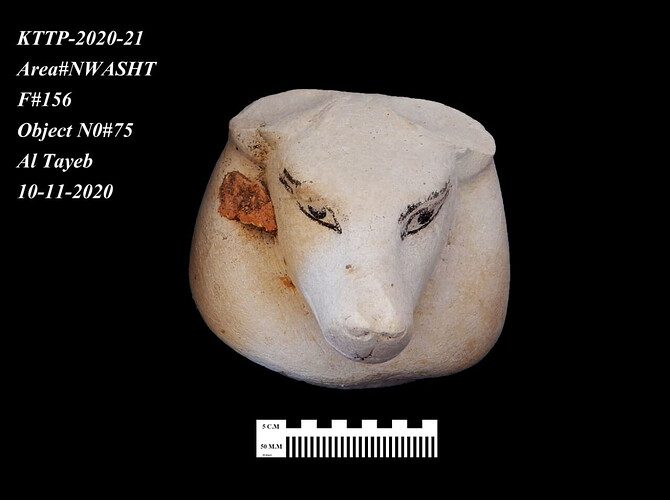Here is Dr. Zahi Hawass Facebook post from Thursday cited below:
- Zahi Hawass Announces Discovery of ‘Lost Golden City’ in Luxor
The Egyptian mission under Dr. Zahi Hawass found the city that was lost under the sands and called: The Rise of Aten. The city is 3000 years old, dates to the reign of Amenhotep III, and continued to be used by Tutankhamun and Ay.
‘Many foreign missions searched for this city and never found it. We began our work searching for the mortuary temple of Tutankhamun because the temples of both Horemheb and Ay were found in this area’ Hawass said.
The Egyptian expedition was surprised to discover the largest city ever found in Egypt. Founded by one of the greatest rulers of Egypt, king Amenhotep III, the ninth king of the 18th dynasty who ruled Egypt from 1391 till 1353 B.C, this city was active during the great king’s co-regency with his son, the famous Amenhotep IV/Akhenaton.
It was the largest administrative and industrial settlement in the era of the Egyptian empire on the western bank of Luxor.
‘The city’s streets are flanked by houses, which some of their walls are up to3 meters high,’ Hawass continued, ‘we can reveal that the city extends to the west, all the way to the famous Deir el-Medina.’
Betsy Brian, Professor of Egyptology at John Hopkins University in Baltimore USA, said ‘The discovery of this lost city is the second most important archeological discovery since the tomb of Tutankhamun”.
“The discovery of the Lost City, not only will give us a rare glimpse into the life of the Ancient Egyptians at the time where the Empire was at his wealthiest but will help us shed light on one of history’s greatest mystery: why did Akhenaten & Nefertiti decide to move to Amarna,” Brian added.
The excavation area is sandwiched between Rameses III’s temple at Medinet Habu and Amenhotep III’s temple at Memnon. The Egyptian mission started working in this area in search of Tutankhamun’s Mortuary Temple.
Tutankhamun’s successor, King Ay, built his temple on a site which was later adjoined on its southern side by Rameses III’s temple at Medinet Habu.
Egyptologists believe Ay’s temple may formerly have belonged to Tutankhamun as two colossal statues of the young king were found there. The northern part of the temple is still under the sands.
The excavation started in September 2020 and within weeks, to the team’s great surprise, formations of mud bricks began to appear in all directions. What they unearthed was the site of a large city in a good condition of preservation, with almost complete walls, and with rooms filled with tools of daily life.
The archaeological layers have laid untouched for thousands of years, left by the ancient residents as if it were yesterday.
The first goal of the mission was to date this settlement. Hieroglyphic inscriptions found on clay caps of wine vessels. Historical references tell us the settlement consisted of three royal palaces of King Amenhotep III, as well as the Empire’s administrative and industrial center.
A large number of archaeological finds, such as rings, scarabs, colored pottery vessels, and mud bricks bearing seals of King Amenhotep III’s cartouche, confirmed the dating of the city.
After only seven months of excavation, several areas or neighborhoods have been uncovered.
In the southern part, the mission found a bakery, a cooking and food preparation area, complete with ovens and storage pottery. From its size, we can state the kitchen was catering a very large number of workers and employees.
The second area which is still partly uncovered, is the administrative and residential district, with larger and well-arranged units.
This area is fenced in by a zigzag wall, with only one access point leading to internal corridors and residential areas. The single entrance makes us think it was some sort of security, with the ability to control entry and exit to enclosed areas.
Zigzag walls are one of the rare architectural elements in ancient Egyptian architecture, mainly used towards the end of the 18th Dynasty. The third area is the workshop.
On one side, the production area for the mud bricks used to build temples and annexes. The bricks have seals bearing the cartouche of King Amenhotep III (Neb Maat Ra).
On the other, a large number of casting molds for the production of amulets and delicate decorative elements. This is further evidence of the extensive activity in the city to produce decorations for both temples and tombs.
All over the excavated areas, the mission has found many tools used in some sort of industrial activity like spinning and weaving.
Metal and glass-making slag has also been unearthed, but the main area of such activity has yet to be discovered.
Two unusual burials of a cow or bull were found inside one of the rooms. Investigations are underway to determine the nature and purpose of this practice.
And even more remarkable burial of a person found with arms outstretched to his side, and remains of a rope wrapped around his knees. The location and position of this skeleton are rather odd, and more investigations are in progress.
One of the most recent finds of a vessel containing 2 gallons of dried or boiled meat (about 10 kg), has a valuable inscription: Year 37, dressed meat for the third Heb Sed festival from the slaughterhouse of the stockyard of Kha made by the butcher luwy.
This valuable information, not only gives us the names of two people that lived and worked in the city but confirmed that the city was active and the time of King Amenhotep III’s co-regency with his son Akhenaten.
The excavation also reveals a mud seal with inscriptions that can be read: “gm pa Aton” that can be translated as “ the domain of the dazzling Aten”, this is the name of a temple built by King Akhenaten at Karnak.
As history goes, one year after this pot was made, the city was abandoned and the capital relocated to Amarna. But was it? And why? And was the city repopulated again when Tutankhamun returned to Thebes?
Only further excavations of the area will reveal what truly happened 3500 years ago.
To the north of the settlement a large cemetery was uncovered, the extent of which has yet to be determined.
So far, the mission has discovered a group of rock-cut tombs of different sizes that can be reached through stairs carved into the rock. A common feature of tomb construction in the Valley of the Kings and in the Valley of the Nobles.
Work is underway and the mission expects to uncover untouched tombs filled with treasures.
زاهي حواس يعلن عن اكتشاف المدينة الذهبية المفقودة في الأقصر
اكتشفت البعثة المصرية برئاسة الدكتور زاهي حواس وزير الآثار الأسبق والمشتركة بين مركز الدكتور زاهي حواس للمصريات التابع لمكتبة الإسكندرية والمجلس الأعلى للآثار "المدينة المفقودة تحت الرمال والتي كانت تسمى “صعود آتون” والتي يعود تاريخها إلى عهد الملك أمنحتب الثالث، واستمر استخدام المدينة من قبل توت عنخ آمون، اي منذ 3000 عام.
وقال الدكتور" زاهي حواس" ان العمل بدأ في هذه المنطقة للبحث عن المعبد الجنائزي الخاص بالملك توت عنخ آمون، لأنه تم العثور على معبدي كل من “حورمحب” و"آي" من قبل".
وأكد “حواس” ان البعثة عثرت علي أكبر مدينة على الإطلاق في مصر والتي أسسها أحد أعظم حكام مصر وهو الملك “أمنحتب الثالث” الملك التاسع من الأسرة الثامنة عشر، الذي حكم مصر من عام 1391 حتى 1353 ق.م. وقد شاركه ابنه ووريث العرش المستقبلي أمنحتب الرابع " أخناتون" آخر ثمان سنوات من عهده.
وأضاف “حواس” ان هذه المدينة هي أكبر مستوطنة إدارية وصناعية في عصر الإمبراطورية المصرية على الضفة الغربية للأقصر، حيث عثر بالمدينة على منازل يصل ارتفاع بعض جدرانها إلى نحو ٣ أمتار ومقسمة إلى شوارع.
وتابع “حواس” لقد كشفنا عن جزء من المدينة يمتد غربا، بينما يعد دير المدينة جزء من مدينتنا".
وبدأت أعمال التنقيب في سبتمبر 2020، وفي غضون أسابيع، بدأت تشكيلات من الطوب اللبن بالظهور في جميع الاتجاهات، وكانت دهشة البعثة الكبيرة، حينما اكتشفت أن الموقع هو مدينة كبيرة في حالة جيدة من الحفظ، بجدران شبه مكتملة، وغرف مليئة بأدوات الحياة اليومية، وقد بقيت الطبقات الأثرية على حالها منذ آلاف السنين، وتركها السكان القدماء كما لو كانت بالأمس.
وقالت الدكتورة “بيتسي بريان”، أستاذة علم المصريات بجامعة جون هوبكنز، إن اكتشاف هذه المدينة المفقودة هو ثاني اكتشاف أثري مهم بعد اكتشاف مقبرة توت عنخ آمون.
وإن اكتشاف هذه المدينة، لم يمنحنا فقط لمحة نادرة عن حياة قدماء المصريين في عصر الامبراطورية، ولكنه أيضاً سيساعدنا في إلقاء الضوء على أحد أعظم الألغاز في التاريخ ولماذا قرر إخناتون ونفرتيتي الانتقال إلى العمارنة؟!
وتقع منطقة الحفائر بين معبد رمسيس الثالث في مدينة هابو ومعبد أمنحتب الثالث في ممنون.
وقد بدأت البعثة المصرية العمل في هذه المنطقة بحثا عن معبد توت عنخ آمون الجنائزي، وكان الملك آي، خليفة توت عنخ آمون هو من قام ببناء معبده على موقع تم تجاوره لاحقًا على جانبه الجنوبي بمعبد رمسيس الثالث في مدينة هابو.
وكان الهدف الأول للبعثة هو تحديد تاريخ هذه المدينة، حيث تم العثور على نقوش هيروغليفية على أغطية خزفية لأواني النبيذ، وتخبرنا المراجع التاريخية أن المدينة كانت تتألف من ثلاثة قصور ملكية للملك أمنحتب الثالث، بالإضافة إلى المركز الإداري والصناعي للإمبراطورية.
وقد أكد عدد كبير من الاكتشافات الأثرية على تاريخ المدينة مثل الخواتم والجعارين والأواني الفخارية الملونة والطوب اللبن الذي يحمل أختام خرطوش الملك أمنحتب الثالث، وبعد سبعة أشهر فقط من التنقيب، تم الكشف عن عدة مناطق أو أحياء بتلك المدينة.
وعثرت البعثة في الجزء الجنوبي على المخبز ومنطقة الطهي وأماكن إعداد الطعام كاملة مع الأفران وأواني التخزين الفخارية، والذي كان يخدم عددًا كبيرًا من العمال والموظفين.
أما المنطقة الثانية، والتي تم الكشف عنها جزئيًا وهي تمثل الحي الإداري والسكني حيث تضم وحدات أكبر ذات تنظيم جيد. وهذه المنطقة مسيجة بجدار متعرج، مع نقطة دخول واحدة فقط تؤدي إلى ممرات داخلية ومناطق سكنية. وهذا المدخل الوحيد يجعلنا نعتقد أنه كان نوعًا من الأمن حيث القدرة على التحكم في الدخول والخروج إلى المناطق المغلقة.
وتعتبر الجدران المتعرجة من العناصر المعمارية النادرة في العمارة المصرية القديمة، وقد استخدمت بشكل أساسي في نهاية الأسرة الثامنة عشر.
أما المنطقة الثالثة فهي ورشة العمل، حيث تضم بإحدى جهاتها منطقة إنتاج الطوب اللبن المستخدم لبناء المعابد والملحقات، ويحتوي الطوب على أختام تحمل خرطوش الملك أمنحتب الثالث (نب ماعت رع).
وتم اكتشاف عدد كبير من قوالب الصب الخاصة بإنتاج التمائم والعناصر الزخرفية الدقيقة، وهذا دليل آخر على النشاط الواسع في المدينة لإنتاج زخارف كل من المعابد والمقابر.
وعثرت البعثة في جميع أنحاء مناطق الحفائر على العديد من الأدوات المستخدمة في النشاط الصناعي مثل أعمال الغزل والنسيج، كما تم اكتشاف ركام المعادن والزجاج، لكن المنطقة الرئيسية لمثل هذا النشاط لم يتم اكتشافها بعد.
كما تم العثور على دفنتين غير مألوفتين لبقرة أو ثور داخل إحدى الغرف، ومازال البحث جار لتحديد طبيعة والغرض من هذه الدفنات
كما تم العثور على دفنة رائعة لشخص ما بذراعيه ممدودتين إلى جانبه، وبقايا حبل ملفوف حول ركبتيه، ويعد موقع ووضع هذا الهيكل العظمي غريب نوعًا ما، وهناك المزيد من البحث حول هذا الأمر.
كما تم العثور على إناء يحتوي على جالونين من اللحم المجفف أو المسلوق (حوالي 10 كجم) ويحمل نقوش قيمة يمكن قراءتها: “السنة 37، لحوم مسلوقة لعيد حب سد الثالث من جزارة حظيرة “خع” التي صنعها الجزار إيوي”.
وهذه المعلومات القيمة لا تعطينا فقط اسمي شخصين كانا يعيشان ويعملان في المدينة، بل يؤكدان أن المدينة كانت نشطة وتحدد زمن مشاركة الملك أمنحتب الثالث مع ابنه أخناتون.
كما عثرت البعثة أيضاً على نص منقوش على طبعة ختم يقرأ: “جم با أتون” أي مقاطعة أتون الساطع، وهذا اسم معبد قد بناه الملك أخناتون بالكرنك.
كما تم الكشف عن مقبرة كبيرة لم يتم تحديد مداها بعد، واكتشفت البعثة مجموعة من المقابر المنحوتة في الصخور بأحجام مختلفة والتي يمكن الوصول إليها من خلال سلالم منحوتة في الصخر، وهناك سمة مشتركة لبناء المقابر في وادي الملوك ووادي النبلاء. ومازال العمل جار وتتوقع البعثة الكشف عن مقابر لم تمسها يد مليئة بالكنوز.
وتتيح أعمال التنقيب المستمرة لعلماء الآثار الوصول إلى طبقة النشاط الأصلية للمدينة، حيث تم كشف النقاب عن معلومات ستغير التاريخ وتعطينا نظرة ثاقبة فريدة عن عائلة توت عنخ آمون.
كما سيقدم لنا اكتشاف المدينة المفقودة أيضًا فهمًا أعمق للحياة اليومية للمصريين القدماء من حيث أسلوب بناء وديكورات المنازل والأدوات التي استخدموها وكيفية تنظيم العمل. وقد تم الكشف عن ثلث المنطقة فقط حتى الآن، وستواصل البعثة أعمال التنقيب، بما في ذلك المنطقة التي تم تحديدها على أنها الموقع المحتمل لمعبد توت عنخ آمون الجنائزي.
واختتم “حواس” لدينا الكثير من المعلومات حول المقابر والمعابد ولكن هذه هي المرة الأولى التي تكشف أسرارًا عن حياة ملوك العصر الذهبي لمصر.*
And some extra pictures from his Facebook account:



The city have been left in a hurry for unknown (perhaps religious I speculate?) reasons, which makes it even more mysterious.








